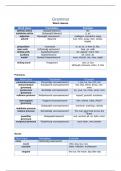Samenvatting
Samenvatting - Engels Docent 2e graads GRAMMAR Jaar 1
- Instelling
- Engels Docent 2e Graads GRAMMAR 1.1 Jaar 1
Dit document is een uitgebreide samenvatting van Engelse grammatica en behandelt de belangrijkste aspecten daarvan. Het bevat gedetailleerde uitleg over woordsoorten (zoals lidwoorden, bijvoeglijke naamwoorden, bijwoorden en werkwoorden), tijden (present, past, future), modale werkwoorden, de lijde...
[Meer zien]




